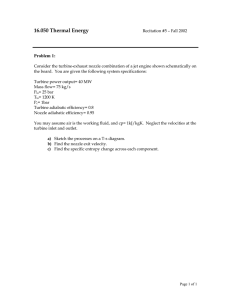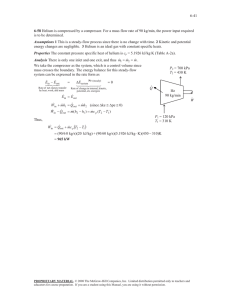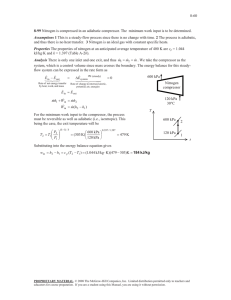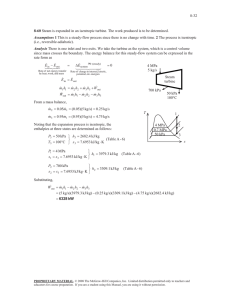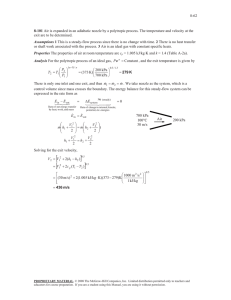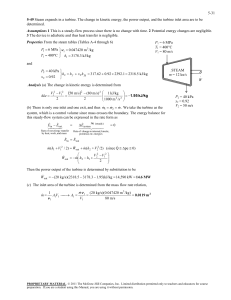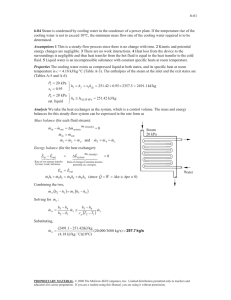An adiabatic air compressor is powered by a direct-coupled steam... ME470 Review Homework SOL --- Instructor : Shoeleh Di... Chapter 5, Solution 184.
advertisement
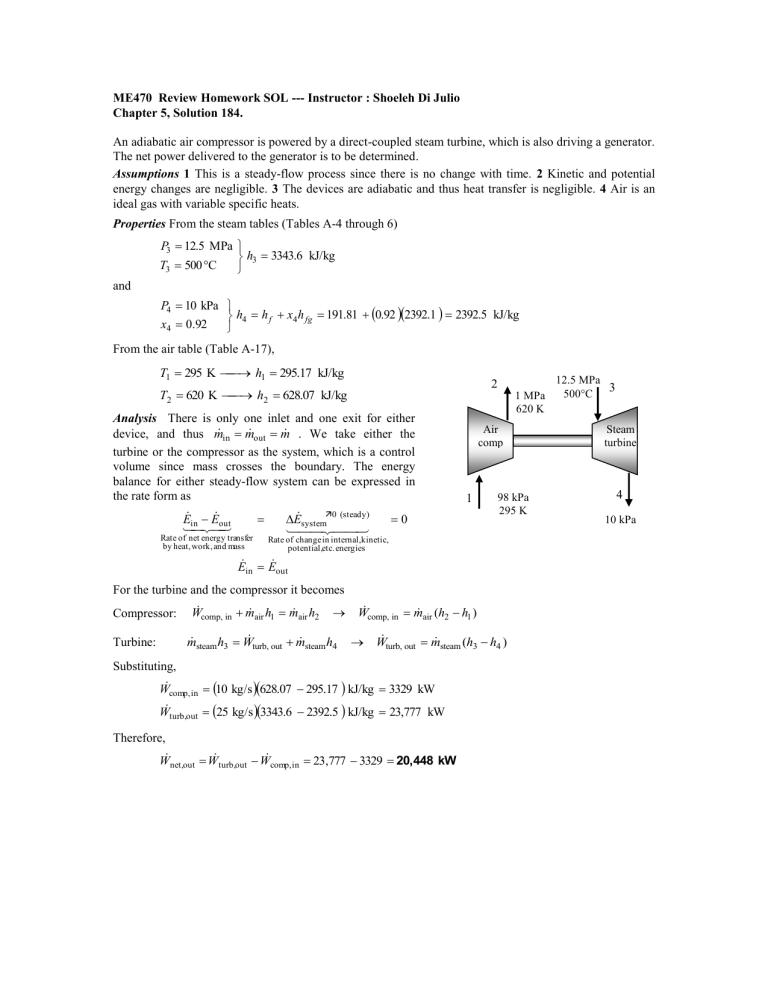
ME470 Review Homework SOL --- Instructor : Shoeleh Di Julio Chapter 5, Solution 184. An adiabatic air compressor is powered by a direct-coupled steam turbine, which is also driving a generator. The net power delivered to the generator is to be determined. Assumptions 1 This is a steady-flow process since there is no change with time. 2 Kinetic and potential energy changes are negligible. 3 The devices are adiabatic and thus heat transfer is negligible. 4 Air is an ideal gas with variable specific heats. Properties From the steam tables (Tables A-4 through 6) P3 12.5 MPa h3 3343.6 kJ/kg T3 500 C and P4 10 kPa h4 h f x4 h fg 191.81 0.92 2392.1 2392.5 kJ/kg x4 0.92 From the air table (Table A-17), T1 295 K h1 295.17 kJ/kg 2 T2 620 K h2 628.07 kJ/kg Analysis There is only one inlet and one exit for either in m out m . We take either the device, and thus m turbine or the compressor as the system, which is a control volume since mass crosses the boundary. The energy balance for either steady-flow system can be expressed in the rate form as E E out in Rate of net energy transfer by heat, work, and mass E system0 (steady) 1 MPa 620 K Air comp 1 0 98 kPa 295 K Rate of change in internal,kinetic, potential,etc. energies E in E out For the turbine and the compressor it becomes Compressor: air h1 m air h2 W comp, in m steam h3 W turb, out m steam h4 m Turbine: air (h2 h1 ) W comp, in m steam (h3 h4 ) W turb, out m Substituting, Wcomp, in 10 kg/s 628.07 295.17 kJ/kg 3329 kW Wturb,out 25 kg/s 3343.6 2392.5 kJ/kg 23,777 kW Therefore, W net,out W turb,out W comp, in 23,777 3329 20,448 kW 12.5 MPa 3 500C Steam turbine 4 10 kPa Chapter 5, Solution 189E. Refrigerant-134a is compressed steadily by a compressor. The mass flow rate of the refrigerant and the exit temperature are to be determined. Assumptions 1 This is a steady-flow process since there is no change with time. 2 Kinetic and potential energy changes are negligible. 3 The device is adiabatic and thus heat transfer is negligible. Properties From the refrigerant tables (Tables A-11E through A-13E) P1 15 psia v1 3.2551 ft 3 /lbm T1 20 F h1 107.52 Btu/lbm 2 Analysis (a) The mass flow rate of refrigerant is m V1 10 ft 3 /s 3.072 lbm/s v1 3.2551 ft 3 /lbm R-134a 1 m 2 m . We take (b) There is only one inlet and one exit, and thus m the compressor as the system, which is a control volume since mass crosses the boundary. The energy balance for this steady-flow system can be expressed in the rate form as E E out in Rate of net energy transfer by heat, work, and mass E system0 (steady) 1 0 Rate of change in internal,kinetic, potential,etc. energies E in E out 1 mh 2 (since Q ke pe 0) W in mh (h2 h1 ) W in m Substituting, 0.7068 Btu/s 3.072 lbm/s h2 107.52 Btu/lbm (45 hp) 1 hp h2 117.87 Btu/lbm Then the exit temperature becomes P2 100 psia T2 95.7F h2 117.87 Btu/lbm Chapter 7, Solution 109. Refrigerant-134a enters an adiabatic compressor with an isentropic efficiency of 0.80 at a specified state with a specified volume flow rate, and leaves at a specified pressure. The compressor exit temperature and power input to the compressor are to be determined. Assumptions 1 This is a steady-flow process since there is no change with time. 2 Kinetic and potential energy changes are negligible. 3 The device is adiabatic and thus heat transfer is negligible. 2 Analysis (a) From the refrigerant tables (Tables A-11E through A-13E), R-134a C = 80% 0.3 m3/min 1 h1 hg @120 kPa 236.97 kJ/kg P1 120 kPa s1 s g @120 kPa 0.94779 kJ/kg K sat. vapor v 1 v g @120 kPa 0.16212 m 3 /kg P2 1 MPa h2 s 281.21 kJ/kg s 2 s s1 From the isentropic efficiency relation, C h2 s h1 h2 a h1 h2 s h1 / C 236.97 281.21 236.97 /0.80 292.26 kJ/kg h2 a h1 Thus, P2 a 1 MPa T2 a 58.9C h2 a 292.26 kJ/kg (b) The mass flow rate of the refrigerant is determined from m V1 0.3/60 m3 /s 0.0308 kg/s v1 0.16212 m3 /kg 1 m 2 m . We take the actual compressor as the system, There is only one inlet and one exit, and thus m which is a control volume since mass crosses the boundary. The energy balance for this steady-flow system can be expressed as E E out in Rate of net energy transfer by heat, work, and mass E system0 (steady) 0 Rate of change in internal,kinetic, potential,etc. energies E in E out Wa,in m h1 m h2 (since Q Δke Δpe 0) Wa,in m (h2 h1 ) Substituting, the power input to the compressor becomes, Wa,in 0.0308 kg/s 292.26 236.97 kJ/kg 1.70 kW Chapter 7, Solution 167. Air flows in an adiabatic nozzle. The isentropic efficiency, the exit velocity, and the entropy generation are to be determined. Properties The gas constant of air is R = 0.287 kJ/kg.K (Table A-1). Assumptions 1 Steady operating conditions exist. 2 Potential energy changes are negligible. Analysis (a) (b) Using variable specific heats, the properties can be determined from air table as follows h1 400 .98 kJ/kg 0 T1 400 K s1 1.99194 kJ/kg.K Pr1 3.806 T2 350 K Pr 2 h2 350 .49 kJ/kg s20 1.85708 kJ/kg.K Air 500 kPa 400 K 30 m/s P2 300 kPa 3.806 2.2836 h2 s 346 .31 kJ/kg Pr1 P1 500 kPa 300 kPa 350 K Energy balances on the control volume for the actual and isentropic processes give h1 400 .98 kJ/kg V12 V2 h2 2 2 2 (30 m/s) 2 1 kJ/kg V22 1 kJ/kg 350 . 49 kJ/kg 2 2 2 2 1000 m 2 /s2 1000 m /s V2 319.1 m/s h1 400 .98 kJ/kg V12 V2 h2 s 2s 2 2 (30 m/s) 2 1 kJ/kg V2s2 1 kJ/kg 346 . 31 kJ/kg 2 2 2 2 1000 m 2 /s2 1000 m /s V2s 331 .8 m/s The isentropic efficiency is determined from its definition, N V22 V2s2 (319 .1 m/s) 2 (331 .8 m/s) 2 0.925 (c) Since the nozzle is adiabatic, the entropy generation is equal to the entropy increase of the air as it flows in the nozzle sgen sair s20 s10 R ln P2 P1 (1.85708 1.99194 )kJ/kg.K (0.287 kJ/kg.K)ln 300 kPa 0.0118 kJ/kg.K 500 kPa Chapter 7, Solution 175. Steam expands in a two-stage adiabatic turbine from a specified state to specified pressure. Some steam is extracted at the end of the first stage. The power output of the turbine is to be determined for the cases of 100% and 88% isentropic efficiencies. Assumptions 1 This is a steady-flow process since there is no change with time. 2 Kinetic and potential energy changes are negligible. 3 The turbine is adiabatic and thus heat transfer is negligible. Properties From the steam tables (Tables A-4 through 6) P1 6 MPa h1 3423.1 kJ/kg T1 500 C s1 6.8826 kJ/kg K P2 1.2 MPa h2 2962 .8 kJ / kg s2 s1 s3s s f 6.8826 0.8320 0.8552 P3 20 kPa x3s s fg 7.0752 s3 s1 h3s h f x3s h fg 251 .42 0.8552 2357 .5 2267.5 kJ/kg Analysis (a) The mass flow rate through the second stage is 3 0.9m 1 0.9 15 kg/s 13.5 kg/s m 6 MPa 500C We take the entire turbine, including the connection part between the two stages, as the system, which is a control volume since mass crosses the boundary. Noting that one fluid stream enters the turbine and two fluid streams leave, the energy balance for this steady-flow system can be expressed in the rate form as E E out in E system0 (steady) Rate of net energy transfer by heat, work, and mass STEAM 13.5 kg/s STEAM 15 kg/s I II 1.2 MPa 20 kPa 10% 0 90% Rate of change in internal,kinetic, potential,etc. energies E in E out m 1h1 (m 1 m 3 )h2 Wout m 3h3 W m h (m m )h m h out 1 1 1 3 2 3 3 m 1 (h1 h2 ) m 3 (h2 h3 ) Substituting, the power output of the turbine is Wout 15 kg/s3423.1 2962.8kJ/kg 13.5 kg2962.8 2267.5kJ/kg 16,291 kW (b) If the turbine has an adiabatic efficiency of 88%, then the power output becomes Wa TWs 0.8816,291kW 14,336 kW Chapter 7, Solution 198. Refrigerant-134a is vaporized by air in the evaporator of an air-conditioner. For specified flow rates, the exit temperature of air and the rate of entropy generation are to be determined for the cases of an insulated and uninsulated evaporator. Assumptions 1 This is a steady-flow process since there is no change with time. 2 Kinetic and potential energy changes are negligible. 3 There are no work interactions. 4 Air is an ideal gas with constant specific heats at room temperature. Properties The gas constant of air is 0.287 kPa.m3/kg.K (Table A-1). The constant pressure specific heat of air at room temperature is cp = 1.005 kJ/kg.K (Table A-2). The properties of R-134a at the inlet and the exit states are (Tables A-11 through A-13) P1 120 kPa h1 h f x1h fg 22 .49 0.3 214 .48 86 .83 kJ/kg x1 0.3 s1 s f x1 s fg 0.09275 0.3(0.85503 ) 0.3493 kJ/kg K T2 120 kPa h2 hg @ 120 kPa 236 .97 kJ/kg sat. vapor s2 hg @ 120 kPa 0.9478 kJ/kg K Analysis (a) The mass flow rate of air is air m P3V3 100 kPa 6 m3/min 6.97 kg/min RT3 0.287 kPa m3 /kg K 300 K We take the entire heat exchanger as the system, which is a control volume. The mass and energy balances for this steadyflow system can be expressed in the rate form as Mass balance ( for each fluid stream): 6 m3/min R-134a AIR 3 1 2 kg/min 2 4 sat. vapor in m out m system0 (steady) 0 m in m out m 1 m 2 m air and m 3 m 4 m R m Energy balance (for the entire heat exchanger): E E out in E system0 (steady) Rate of net energy transfer by heat, work, and mass 0 Rate of change in internal,kinetic, potential,etc. energies E in E out m 1h1 m 3h3 m 2 h2 m 4 h4 (since Q W ke pe 0) Combining the two, R h2 h1 m air h3 h4 m airc p T3 T4 m m R h2 h1 m air c p Solving for T4, T4 T3 Substituting, T4 27 C (2 kg/min)(23 6.97 86 .83) kJ/kg 15.9C = 257.1 K (6.97 kg/min)(1. 005 kJ/kg K) Noting that the condenser is well-insulated and thus heat transfer is negligible, the entropy balance for this steady-flow system can be expressed as Sin Sout Rate of net entropy transfer by heat and mass Sgen Ssystem0 (steady) Rate of entropy generation Rate of change of entropy m 1s1 m 3s3 m 2 s2 m 4 s4 Sgen 0 (since Q 0) m R s1 m air s3 m R s2 m air s4 Sgen 0 or, Sgen m R s2 s1 m air s4 s3 where 0 s 4 s 3 c p ln T4 P T 257.1 K R ln 4 c p ln 4 (1.005 kJ/kg K) ln 0.1551 kJ/kg K T3 P3 T3 300 K Substituting, Sgen 2 kg/min 0.9478 - 0.3493 kJ/kg K (6.97 kg/min)( 0.1551 kJ/kg K) 0.116 kJ/min K 0.00193 kW/K (b) When there is a heat gain from the surroundings at a rate of 30 kJ/min, the steady-flow energy equation reduces to Q in m R h2 h1 m airc p T4 T3 Qin m R h2 h1 airc p m Solving for T4, T4 T3 Substituting, T4 27 C + (30 kJ/min) (2 kg/min)(23 6.97 86 .83) kJ/kg 11.6 C 261 .4 K (6.97 kg/min)(1. 005 kJ/kg K) The entropy generation in this case is determined by applying the entropy balance on an extended system that includes the evaporator and its immediate surroundings so that the boundary temperature of the extended system is the temperature of the surrounding air at all times. The entropy balance for the extended system can be expressed as Sin Sout Rate of net entropy transfer by heat and mass Sgen Ssystem0 (steady) Rate of entropy generation Rate of change of entropy Qin m 1s1 m 3s3 m 2 s2 m 4 s4 Sgen 0 Tb,out Qin m R s1 m air s3 m R s2 m air s4 Sgen 0 Tsurr or Q Sgen m R s2 s1 m air s4 s3 in T0 where s 4 s 3 c p ln 0 T4 P 261.4 K R ln 4 (1.005 kJ/kg K) ln 0.1384 kJ/kg K T3 P3 300 K Substituting, 30 kJ/min Sgen 2 kg/min 0.9478 0.3493 kJ/kg K 6.97 kg/min 0.1384 kJ/kg K 305 K 0.1340 kJ/min K 0.00223 kW/K Discussion Note that the rate of entropy generation in the second case is greater because of the irreversibility associated with heat transfer between the evaporator and the surrounding air.
